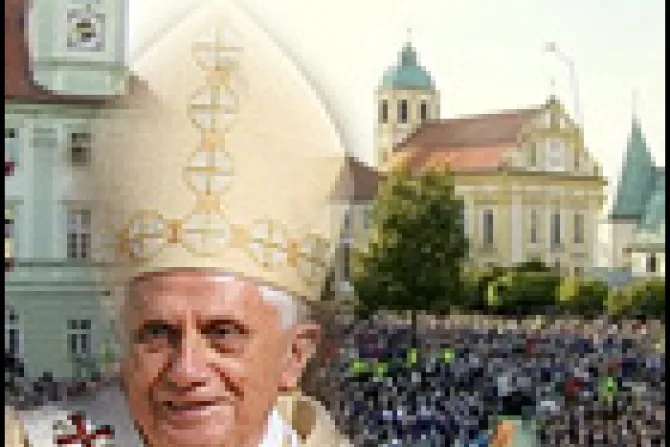Sep 10, 2006 / 22:00 pm
The Marian Shrine of Altötting, one of Bavaria’s most famous pilgrimage sites, was an appropriate place for the second Mass celebrated by the Pope Benedict XVI on his trip home. Mary, the Mother of God and “woman of prayer,” would be the subject of the New Testament readings as well as the homily of the Holy Father.
The Shrine, which was created in 680 AD, is most famous now for the “Black” Madonna, a statue last visited by Pope Benedict with his brother, Fr. Georg Ratzinger, on a private pilgrimage before his Pontifical election in 2005. Since the addition of the statue sometime around 1330, soot from thousands of candles burned before the image has stained her head a dark color earning the sculpture the “black” moniker.
The very small town of Altötting, located a mere 100 km from Munich, swelled with well over 35,000 Catholics wishing to have the rare opportunity of attending a mass celebrated by the Bishop of Rome. Though the venue allowed for much smaller crowds than the initial Munich Mass, the streets of the town were filled to capacity on a beautiful sunny day.
Pope Benedict began the celebration after working his way through a throng of admirers on a sunny Monday morning. His smile could not be contained as he received an official greeting from, Bishop Wilhelm Schraml, of Passau welcoming the Holy Father “home.”
Benedict began his homily by noting, “In today’s First Reading, Responsorial Psalm and Gospel, three times and in three different ways, we see Mary, the Mother of the Lord, as a woman of prayer.”
Standing behind the crimson marble altar the Holy Father addressed the gathered Catholics about the significance of the first reading from the Acts of the Apostles. In the upper room “Mary leads the nascent Church in prayer; she is, as it were in person, the Church at prayer,” the Pontiff instructed. “And thus, along with the great community of the saints and at their centre, she stands even today before God interceding for us.”
Benedict continued on, delving deep into the meaning surrounding the Gospel’s story of the wedding at Cana. The Holy Father commented that “Mary does not really ask something of Jesus: she simply says to him: "They have no wine" (Jn 2:3).” In this way, “Mary leaves everything to the Lord’s judgment.”
“This is how she teaches us to pray: not by seeking to affirm our own will and our own desires before God, but by letting him decide what he wants to do,” the Pope said.
The Pope reminded the congregation of a similar encounter with Mary’s willingness to turn over her will at the Annunciation. “At Nazareth she gave over her will, immersing it in the will of God.”
Pope Benedict also explained that Jesus does not dismiss his mother when he states, “My hour has not yet come" (Jn 2:4). Instead, the Holy Father noted, He is indicating that his, “definitive ‘hour’ will be his return at the end of time.”
“And so,” the Holy Father stated, “we want to let ourselves be guided by Mary, by the Mother of Graces of Altötting, by the Mother of all the faithful, towards the "hour" of Jesus.”
The Holy Father concluded his Homily by again encouraging the congregation to allow Mary to lead them into a deeper and more sacrificial prayer life. As the Pope was seated, the faithful erupted in spontaneous applause.
During the Mass, the Pope made a special mention of September 11 2001. "Five years on from the terrorist attacks against the World Trade Center in New York," he said, "we pray for peace in the world."
At the conclusion of the Mass the Pope processed, along with the Blessed Sacrament and the Statue of the Blessed Virgin Mary, to a newly constructed Adoration Chapel. There the Pontiff blessed the new chapel and installed the Eucharist for perpetual adoration.
Later in the day Pope Benedict will be conducting Marian Vespers with the religious and seminarians of Bavaria at the Basilica of St Anne.


